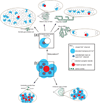Are unreliable release mechanisms conserved from NMJ to CNS?
- PMID: 23102681
- PMCID: PMC4076818
- DOI: 10.1016/j.tins.2012.09.009
Are unreliable release mechanisms conserved from NMJ to CNS?
Abstract
The frog neuromuscular junction (NMJ) is a strong and reliable synapse because, during activation, sufficient neurotransmitter is released to trigger a postsynaptic action potential (AP). Recent evidence supports the hypothesis that this reliability emerges from the assembly of thousands of unreliable single vesicle release sites. The mechanisms that govern this unreliability include a paucity of voltage-gated calcium channels, a low probability of calcium channel opening during an AP, and the rare triggering of synaptic vesicle fusion even when a calcium channel does open and allows calcium flux. Here, we discuss the evidence that these unreliable single vesicle release sites may be the fundamental building blocks of many types of synapses in both the peripheral and central nervous system (PNS and CNS, respectively).
Copyright © 2012 Elsevier Ltd. All rights reserved.
Figures


References
-
- Zhai RG, Bellen HJ. The architecture of the active zone in the presynaptic nerve terminal. Physiology (Bethesda) 2004;19:262–270. - PubMed
-
- Katz B. The Release of Neural Transmitter Substances. Liverpool: Liverpool University Press; 1969.
-
- Stevens CF. Neurotransmitter release at central synapses. Neuron. 2003;40:381–388. - PubMed
-
- Schneggenburger R, Neher E. Presynaptic calcium and control of vesicle fusion. Curr. Opin. Neurobiol. 2005;15:266–274. - PubMed
-
- Llinás R, et al. The concept of calcium concentration microdomains in synaptic transmission. Neuropharmacology. 1995;34:1443–1451. - PubMed
Publication types
MeSH terms
Grants and funding
LinkOut - more resources
Full Text Sources
Other Literature Sources

